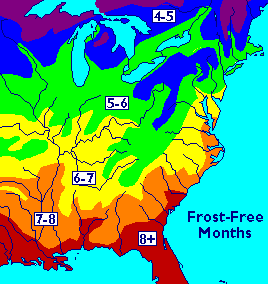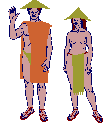
Southern Farmers
The transition from North to South is very gradual. In the early days of American history, the northern limit of plantation slavery pretty much followed the line which marks the 6-month growing season. The 6-month line also divided the ham, grits, tobacco and Baptists of the south from the beef, oatmeal, beer and Presbyterians of the north, and during the Civil War, it divided Confederate sympathizers from Unionist ones. In Medieval America, plantation slavery is the norm throughout the farming zone, both north and south, but the 6-month growing season still marks the transition from cattle and wheat to hogs and corn.

The southern lifestyle intensifies in the lands with a 7-month growing season, the traditional home of the cotton belt. In early history, slaves comprised around a quarter of the population of the 6-7 month zone, but nearly half in the 7-8 month zone, so here were the first states to secede during the Civil War. In Medieval America, however, heavily armed slave states are everywhere, so rather than comment on this, a northern tourist crossing into the 7-month growing season is likely to note in his journals, "Omigosh! Everyone's naked!", and then complain about the spicy food. The medieval South really begins here.
By the time we reach the 8-month growing season, the world we've entered in downright Caribbean in culture.
Food:
Corn bread, sweet potatoes, tomatoes and black-eyed peas are among the staples of the southern diet. Southerners also rely on the hog as a major food source. In most of North America, farmers prefer to raise animals that and eat undigestible grass and produce useful wool or milk, rather than hogs, which produce nothing but meat and need human food, but with the rich biology of the south, the hog can be left to forage in the woods for acorns and such until needed, so it's not as big a burden.Southern cuisine tends to be very spicy because the body perceives the spices as hot (they really aren't), so it overreacts, thereby cooling itself down. This can be a very useful reaction to provoke in a sub-tropical summer.
Clothing:
Although the South's principle export is textiles, in the stifling heat of the deep south, clothes can get very uncomfortable, so the inhabitants try to avoid them. Of course, summers are hot in the north too, but you don't see them wandering around naked. The difference is that the bitter winters of the north reinforce the habit of wearing clothes, and the short summers never give them a chance to get used to anything else. Southerners, on the other hand, have no good reason to stay all wrapped up. They might wear a light cotton poncho and wide straw hat to keep the sun from bothering them, and they might wear a loincloth to keep the preachers from bothering them, but they are pretty much naked otherwise.
Attitude:
Maybe the stereotypes of the hot-blooded southerner are completely without basis, or maybe not. In the deep south, children spend a great deal of time outdoors, so they become accustomed to their independence. A southerner is therefore more likely to resent a neighbor's intrusion into his affairs, to avenge an insult, and to seek instant gratification. Because, they are more likely to show their emotions (anger, love, friendship, what have you), their music is passionate and rhythmic, and they are more likely to incorporate dance and ecstatic trances in their religious rituals.


[Tips]
Last Updated January 2003
Copyright © 1999-2003 Matthew White